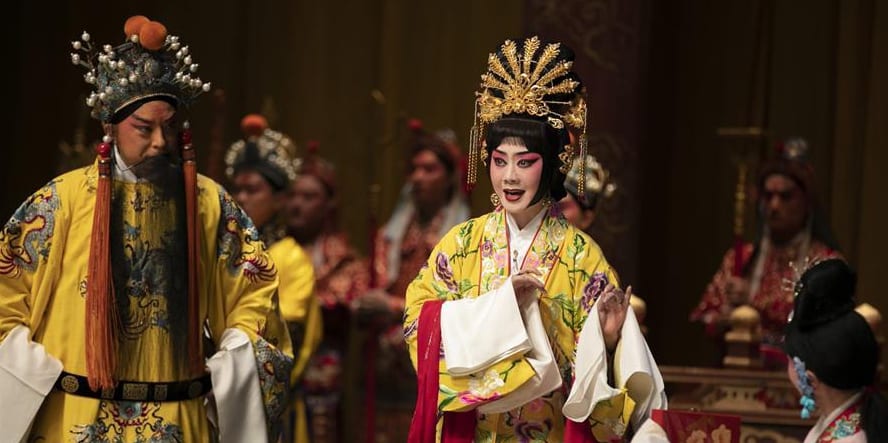Who needs the shock of the new when there is the shock of the old? Chinese opera theatre has been entertaining Chinese audiences for a thousand years, and its origins go back at least another thousand years. But for the Westerner, it’s all news.
While the form is astonishingly novel, alien to the Western eye and ear, the plot lines of The Emperor and the Concubine are satisfyingly familiar. There is a romantically joyful, sad, and then a sadly-joyful love story. Subtly, we are given much more. There is also the rags to riches story, and the story of greed and political betrayal, and the story of divided loyalty (romantic love versus the love of one’s country), and the story of the sacrifice of life for the sake of love. Thrown in for good measure is a wonderfully erotic bath scene where nobody gets naked or even much moves a muscle, and there are athletic displays of ritualized combat (one must wait until after the interval for this), and there is a magnificently and movingly staged suicide, and a journey to the stars.
The pure opera form employed by Peking Opera bears almost no relation to anything we are familiar with. The musical scale and the singing voice, and use of the body language – eyes, hands, costume, make-up, mode of walking, the movements of the “water-sleeves”, all codes of understated communication to the audience. All the while, the face and body return to a simulated repose, a changing tableau. Even in the combat scenes, aerial acrobatics are followed by magically instantaneous immobility. This is an excellent introduction to an otherness.
The Emperor and the Concubine was devised in the 1920s by the legendary Peking Opera Master Mei Lanfang (1894-1961). The performance at Sadler’s Wells is led by Peking Opera’s hugely esteemed stars Yu Kuizhi and Li Shengsu, exponents of his style. Peking Opera (or Jingju as it is known in China) is one amongst some 350 regional forms of opera in China, all famous for uniting in their productions the expertise of performers of music, song, dance, combat and acrobatics. The CNPOC comprises “groups” that specialise in different types of performance and stagecraft, including martial arts, ancient creative skills and new technologies, and the group visiting Sadler’s Wells now is of the Mei School.
The love story is set mainly in the palace of the Emperor Tang Ming Huan during the Tang dynasty (618-907 A.D.), in the city of Chang’an which was then the capital of China. At the time, it was the terminus of the Silk Road, the route for both trade and cultural exchange with the rest of the known world. The Peking Opera tour is a part of the contemporary version of the Silk Road, namely China’s “Belt and Road” initiative.
The Chinese National Peking Opera Company was first established in January 1955, and since then has grown into the largest performance arts hub in the country, operating under the auspices of the Ministry of Culture of the People’s Republic of China. Aside from its award-garnering status within its borders, the CNPOC is charged with supporting international cultural exchange. It has performed in fifty countries on five continents and this is its fourth tour Britain. They will be back next year: if you have a chance to see them, do take it.

